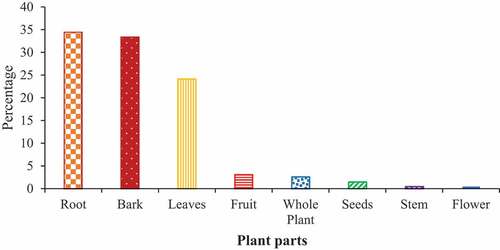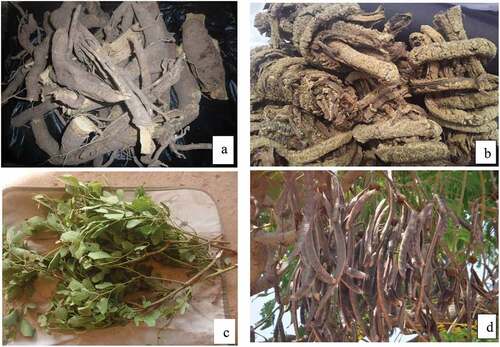ABSTRACT
Change in land use affects the conservation of medicinal plants. We assessed the abundance and richness of medicinal plants under different land-use systems in Ghana. The land-use types consisted of protected area (PA), Fallowed Land (FL) and Farmed area (FA). A total of 45 quadrats (30 m × 30 m) were laid randomly and medicinal plants identified. Soil samples (0–15 cm) were also collected from nested quadrats for physiochemical analysis. Additionally, ethnobotanical survey of 210 key informants was carried out using Snowball sampling method to identify plant parts used and ailments treated. The result identified 107 species of medicinal plants, and the roots (34.4%) and bark (33.3%) were mostly used. PA had higher (P < 0.05) abundance (81.75 ± 6.74) and richness (19.80 ± 0.96) while FA had the least. The principal component analysis (PCA) showed that PC1 accounted for 48.7% of the variance with abundance (0.8092), richness (0.9168), TN (0.9312) and ECEC (0.7789) positively loaded on it. The PC2 accounted for 24.1% of the variance in the soil physical properties. We established that integrating medical plants into crops as Agroforestry system can improve their conservation. Our findings have implications for the attainment of the sustainable development goals (SDGs) 3 , 13 and 15 .
1. Introduction
A crucial point related to the preservation and protection of our environment is plant species richness and abundance in land-use changes with anthropogenic interventions that usually led to the extinction of native species. Plant species richness and abundance is an essential biodiversity in Africa that provide essential ecosystem goods and services to indigenous livelihoods (Coulibaly et al., Citation2021; Atumane & Cabral, Citation2021; Garcia‑Vega and Newbold, 2020; Tekalign et al., Citation2017). Unfortunately, changes in land-use practices have been identified as a major cause of biodiversity loss (Cebrián-Piqueras et al., Citation2017; Siebert et al., Citation2021) and are of grave concern in Africa.
It is worth mentioning that the sustainable development goal (SDG) 15.3.1 aims to combat desertification and land degradation and to promote soil and habitat conservation and restoration. Among the key indicators, however, are land-use changes, land productivity and above- and belowground carbon stocks (Pandit et al., Citation2020). Therefore, knowledge on tree species abundance and richness is critical for sustainable land management, biodiversity conservation (Coulibaly et al., Citation2021) and the ultimate achievement of SDG 15. For instance, Negash et al. (Citation2012) suggested that tree species abundance and richness could be affected by land-use types and climate/soil factors. However, there has been few studies to assess the effect of land use on the edaphic (soil) properties and plant species richness, even in recent times (Buhk et al., Citation2017; Knudsen et al., Citation2017; Triantafyllidis et al., Citation2020).
In that regard, Rodrigues et al. (Citation2018) expressed concern about the large knowledge gap regarding the relationship between attributes of plant communities and soil characteristics in the same landscape. They further suggested that future studies need to include the distribution of species and their respective abundances in relation to edaphic (influenced by the soil) variables in order to better understand the processes involved in the soil–vegetation relationship.
It is important to state that there is evidence (Egeru et al., Citation2019; Nwaogu et al., Citation2016; Smith et al., Citation2019) to suggest that tree species could give an indication of differences in soil physicochemical properties.
Therefore, we assessed the abundance and richness of medicinal plants as influenced by variation in the physicochemical properties of soils and land-use types in the Guinea Savanna zone of Northern Ghana. Land-use change and soil conditions may threaten the supply of medicinal plants, especially in semi-arid Savanna zone of Northern Ghana where significant number of people depend on herbal medicine as source of income, health and livelihood (Agbodeka et al., Citation2016; Dogor et al., Citation2018).
The Guinea Savanna zone of Northern Ghana is considered the driest region of Ghana with unimodal rainfall lasting for only 4 to 6 months. As per our review, this is the first study that has looked at both medicinal plant species structural richness and abundance in relation to soil physiochemical properties in dryland environment. For instance, a recent study by Coulibaly et al. (Citation2021) reported that there is scanty data on abundance and richness of tree species in different land management types in the savannah landscape of Ghana. In addition, García-Vega and Newbold (Citation2020) posited the need for more studies to be conducted in drylands in order to determine with more confidence whether richness and abundance differ across land uses. Such a study is important since the consequences of such land-use changes affect ecosystem functioning, given the great human demographic importance of dryland environments (United Nations Environment Management Group, Citation2011).
Our focus on medicinal plants stems from the fact that they are widely utilised in Ghana for a wide range of ailments (Agyei-Baffour et al., Citation2017; Amponsah et al., Citation2016; Appiah et al., Citation2018; Boadu & Asase, Citation2017; Boateng et al., Citation2016; Mensah et al., Citation2019).
In this regard, the Traditional and Alternative Medicine Directorate (TAMD), Centre for Plant Medicine Research (CPMR) and the Traditional Medical Practitioners Council (TMPC) have been established to promote, control and regulate the traditional/herbal medicine industry in Ghana. Unfortunately, there is growing concern about the loss of medicinal plants (Agbodeka et al., Citation2016; Amujoyegbe et al., Citation2016; Dogor et al., Citation2018; Youmsi et al., Citation2017) due to changes in land-use and soil properties. We believe that an improved understanding of the community ecology of medicinal plants across land-use types will indicate how these plants are affected by land-use changes and how they can be maintained under increasing land-use pressure and drought considering the role they play in the health and wellbeing of rural people. We hypothesised that the abundance and richness of medicinal plants would be influenced by variation in the physicochemical properties of soils and the different land-use types.
2. Materials and method
2.1. Study area
Three communities of the Guinea Savanna zone of Northern Ghana were selected for the study () based on the changes in land use, the abundance and role of medical plants in the health needs of the people. In addition, medicinal plants have economic importance in the lives of the people in these communities. For instance, medicinal plant collectors (suppliers) and vendors depend on the sale of these medicinal plants for income, while traditional healers either charge or get voluntary payment after patient are healed.
Figure 1. Map of Ghana showing the selcected districts (in circle) of the study areas in the Guinea Savanna zone of Northern Ghana.
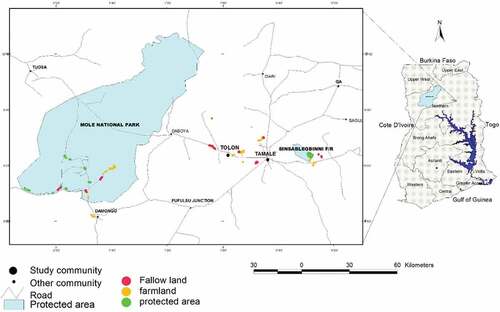
The communities were Mognori in the Mole National Park in the West Gonja District (9° 5′ 0″ N, 1° 49′ 0″ W), Jagbo-Apleyi near the Chinfoyiri Sacred Grove in the Tolon District (9° 26′ 0″ N, 1° 4′ 0″ W) and Tugu near the Sinsablegbinnni Forest Reserve (9° 24′ 30.31″ N, 0° 50′ 25.63″ W), in the Tamale Metropolis.
The natural vegetation of the Guinea Savanna zone of Northern Ghana is predominately tall grasses with scattered trees and shrubs with well-defined wet and dry seasons. The mean annual rainfall ranged 900–1100 mm. The wet season starts in April/May and ends in October, with maximum rainfall occurring around the month of August to September.
The dry season, where there is no rainfall with high temperature (29–33 °C), usually starts in November and ends around April/May. The mean monthly temperatures are high throughout the year ranging from 25°C to above 33°C. Relative humidity ranges from 75% in the raining season to 35% in the dry and hot periods (Nketia et al., Citation2018).
2.2. Description of land-use types
The land-use types consisted of protected area (PA), fallowed land (FL) and farmed area (FA) (see pictures in Supplementary Material 1). The PAs were lands that were secured from human disturbances. They are sacred groves that are conserved and maintained through a mechanism of beliefs, taboos, prohibitions and restrictions. Burning, cutting of grass and fuelwood are prohibited in these areas. These traditional beliefs have led to the preservation of numerous tree and shrub species in the study areas. The PA provides some ecological services to fringing communities in the form of purification of water in rivers and streams, conservation of biodiversity, prevention of natural hazards like windstorms, climate regulation, soil formation and nutrient cycling, erosion control and provision of genetic resources.
Farmlands were agroforestry parklands that have been under cultivation continuously for at least the past five years. Tree species such as Parkia biglobosa, Faidherbia albida and Vitellaria paradoxa are selectively preserved, maintained and managed on croplands by farmers and are used as a regular source of fuelwood, fodder, herb or other timber products. In addition, the biomass of the legume trees and shrubs is used as a source of organic manure for soil fertility enrichment. The common crops grown include maize, cowpea, groundnut, yam, Pigeon pea, millet and cassava.
The FLs are lands that had been left uncultivated (fallow) for not less than five years. These are previously Agroforestry parklands that have exhausted their fertility and farmers allow the soil to regain its productivity through natural regeneration, thus, forest undergoing natural regeneration following agricultural land use or on former croplands and grazing Lands. On few occasions, farmers intervene with the planting of perennial legumes, like Pigeon pea (Cajanus cajan (L.) Huth) to help facilitate the regeneration process or enrichment of the soil fertility.
The existing tree provide some products (shea fruit, dawadawa fruits, etc) to women in the community but cropping is prohibited during the fallow period.
2.3. Sampling procedure
A reconnaissance survey was carried out in July and August, 2018 during which the study plots were identified, and the soil samples were taken in September, 2018. The study sites were identified based on the availability of PAs that were well monitored and secured from human disturbances, and it also had fallow lands which were previously agroforestry parklands that had been left fallow for not less than five years. The farmlands were identified with the help of the farm owners who confirmed that they had been cultivating that same piece of land continuously for at least the past five years.
In the first comparative studies, a total of 45 quadrats of 30 × 30 m each were laid randomly within a field following the process of Pérez‐Salicrup et al. (Citation2001), which consists of nine (9) quadrats each, laid in the PA, fallow lands (FL) and farmlands (FA) in the three communities. In each community, the land-use types were about 500 m apart. The main factor consisted of the three (3) levels of land-use type (protected, fallow and farmlands) and the second factor also consisted of three (3) different locations Mognori, Jagbo and Tugu in the Gonja West, Tolon Community and Tamale Metropolis, respectively, giving a total of nine (9) treatments.
Soil samples were collected using a soil augur at depths of 0–15 cm in each of the 45 quadrats. For each quadrat, five soil samples were obtained from 5 × 5 m nested quadrats which were placed at each of the four corners and one in the centre. For each quadrat, the five samples were thoroughly mixed and two subsamples were taken for soil analysis in duplicates giving a total of 90 samples.
The samples were air-dried for three (3) days, ground and sieved with a 2-mm mesh to remove extraneous materials like roots and pebbles and mixed thoroughly.
Some soil physical and chemical properties such as soil texture, pH, soil organic carbon, total nitrogen, available phosphorus, extractable bases (Ca, Mg, K and Na), exchangeable acidity (EA) and effective cation exchange capacity (ECEC) were determined.
2.4. Abundance and richness of medicinal plants/inventory of medicinal plants
A stratified randomised design was used to lay a total of 225 quadrats of 30 × 30 m each following the Pérez‐Salicrup et al. (Citation2001) method, consisting of 25 nested quadrats from June to September 2018. A total of nine (9) treatments were obtained consisting of three (3) levels of communities, namely, Mognori, Tolon and Tugu and three (3) levels of land-use type denoted by PA, FL and FA. Within each nested quadrat, 5 m × 5 m and 1 m × 1 m quadrats were laid to assess shrubs and herbaceous or ground cover medicinal plant species, respectively.
Each quadrat was systematically surveyed and the abundance of medicinal plant species was recorded. Voucher specimens of the plants of medicinal value were collected to verify their identity by a taxonomist at the Herbarium of the Faculty of Agriculture, University for Development Studies (UDS) after preliminary visit to medicinal market, venders and healers in each selected community. Names of the identified plant species followed the International Plant Names Index (http://www.ipni.org) and the Plant List (http://www.theplantlist.org) which was established by a collaboration between botanical communities spearheaded by the Kew and Missouri Botanical Gardens.
2.5. Ethnobotanical survey of medicinal plants
The ethnobotanical survey of medicinal plants was carried out in the three (3) selected districts (West Gonja, Tolon and Tamale Metropolis). A total of 210 key informants in 30 villages, consisting of seven respondents per village, were interviewed using semi-structured questionnaires (Supplementary material 2). The Snowball sampling method was used to identify respondents comprising of the major players in the medicinal plant community.
These consisted of herbal practitioners, medicinal plant collectors (suppliers) and vendors.
The ethnobotanical survey helped to know how people use such plants, parts of plant used for herbal remedies, mode of preparations, administration routes and the categories of uses.
For example, key questions were ‘Which medicinal plant species are used for the treatment and prevention of various diseases and ailments?’, ‘Which plant parts are used in the preparation of herbal remedies?’, ‘Is there a consensus agreement between the informants regarding the uses of particular medicinal plant(s) for the treatment of particular disease categories?’ ‘What is the extent of availability and perceived dynamics of medicinal plants by local people in the study area?’ and ‘Which species are of great concern and need to be prioritized for conservation?’.
2.6. Data analysis
The data were subjected to two-way analysis of variances (ANOVA) using the ‘car’ and ‘MASS’ packages of the R statistical software version 3.4.1 to test for significant differences between means with a 5% significance level. Where there were significant interactions, Tukey’s HSD post hoc tests for multiple comparisons were carried out to show significant differences in the means of the various treatments (P < 0.05). Additionally, Pearson’s correlation analysis was performed to explore the relationships between the physicochemical properties of the soil samples. Additionally, principal component analysis (PCA) was performed to explore the relationship between the physicochemical properties of the soil and the abundance of medicinal plants in the three land-use types and the major cause of the spatial variability using the ‘FactoMineR’ and ‘factoextra’ packages of the statistical software R version 3.4.1 (R Core Team, 2017).
3. Results
3.1. Richness of medicinal plants
A total of 107 distinct species, 87 genera and 40 families of medicinal plants were identified (). These were distributed in five life forms, namely, trees (69.2%), shrubs (23.4%), herbaceous plants (2.8%), creepers (0.9%) and lianas (3.7%). The Leguminosae family was the most represented (29 species), followed by Combretaceae (9 species), Rubiaceae (8 species), Anacardiaceae, Apocynaceae, Meliaceae and Moraceae (4 species each); Euphorbiaceae and Loganiaceae (3 species each) and the remaining 31 families were represented by either two or a single species ().
Table 1. Medicinal plants and ailments used for treatment in the Savanna zone of Northern Ghana.
3.2. Abundance and richness of medicinal plants
The abundance (ha−1) of medicinal plants was significantly influenced by land-use type (F2,36 = 27.316, P = 0.000) and community (F2,36 = 22.903, P = 0.000). The abundance of medicinal plants ranged from 35.21 ± 7.64 in the FA to 81.75 ± 6.74 in the PA (). The PA tended to have a higher abundance of medicinal plants than the FL and FA. The abundance of medicinal plants in the communities started from 45.77 ± 5.26 in Jagbo and it increased to 83.09 ± 7.70 in Mognori as the highest ().
Figure 2. Effects of land-use type (a) and community (b) on the abundance (ha−1) of medicinal plants in the Guinea Savanna zone of Northern Ghana.
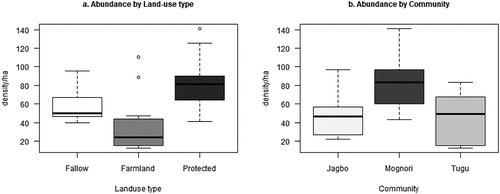
Similarly, species richness was significantly influenced by the different land-use types (F2,36 = 122.904, P = 0.000) and communities (F2,36 = 18.529, P = 0.000). Species richness ranged from 11.20 ± 1.10 in the FA to 19.80 ± 0.96 in the protected (). The PA tended to have a higher species richness of medicinal plants than the FL and FA.
Figure 3. Effects of land-use type (c) and community (d) on species richness (per plot) of medicinal plants in the Savanna zone of Northern Ghana.
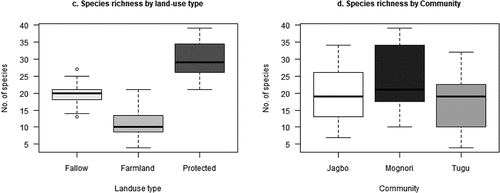
In the communities, the Mognori (24.53 ± 2.41) had the highest species richness of medicinal plants than the Tugu (17.67 ± 2.12) and Jagbo ().
3.3. Principal component analysis of abundance, species richness of medicinal plants and physicochemical properties of soil
The PCA of the abundance and species richness of medicinal plants and 14 physicochemical properties of soil in the different land use types yielded five components that were extracted (). The first two components accounted for 72.1% of the total variance in the original data set. On PC1 (principal component one), 12 out of the 16 variables with positive values loaded heavily on it. These consisted of abundance per hectare of medicinal plants (0.8092), species richness (0.9168), pH (0.8874), TN (0.9312), Pav (0.7748), SOC (0.9353), exchangeable Ca (0.6682), exchangeable Mg (0.6901), exchangeable K (0.6148), exchangeable Na (0.7345), ECEC (0.7789) and %BS (0.6685; ).
Table 2. PCA results for the variables extracted from the abundance and species richness of medicinal plants and 14 soil physicochemical properties in the land-use types and the communities in the Guinea Savanna zone of Northern Ghana.
The PC1 accounted for 48.7% of the variance in the linear combination of abundance, species richness of medicinal plants and soil chemical properties (). The PC2 had four soil properties that loaded heavily on it, namely, sand (−0.9493) which was negative while silt (0.9304), clay (0.9430) and bulk density (0.7693) were positive. The PC2 represented the soil physical properties which accounted for 24.1% of the variance in the soil properties ().
Figure 4. Correlation circle showing the covariates in a two-dimensional plot (Dim 1 × Dim2) in the Savanna Zone of Northern Ghana. SOC = SOC (%), N = TN (%), P = available phosphorus, Ca = calcium, K = potassium, Na = sodium, ECEC = effective cation exchange capacity, PBS = percentage base saturation, BD = bulk density, Sand = sand (%), Silt = Silt (%), Clay = clay (%).
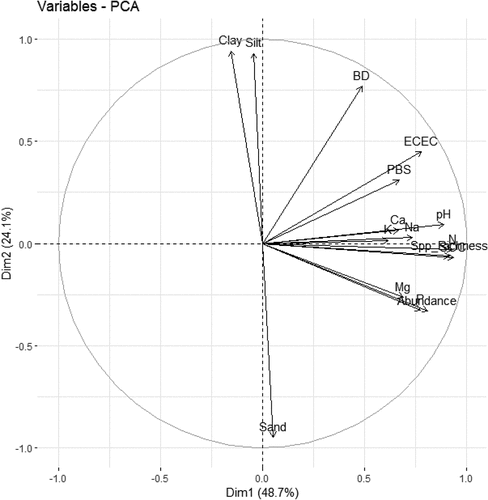
Figure 5. Visualisation of abundance and species richness of medicinal plants and the physicochemical properties of soils in a two-dimensional plot (Dim1 × Dim2) in the Savanna Zone of Northern Ghana. MP = Mognori protected area (PA); MFL = Mognori fallow land, MF = Mognori farmland, JP = Jagbo PA; JFL = Jagbo fallow land, JF = Jabgo farmland, TP = Tugu PA; TFL = Tugu fallow land, TF = Tugu farmland.
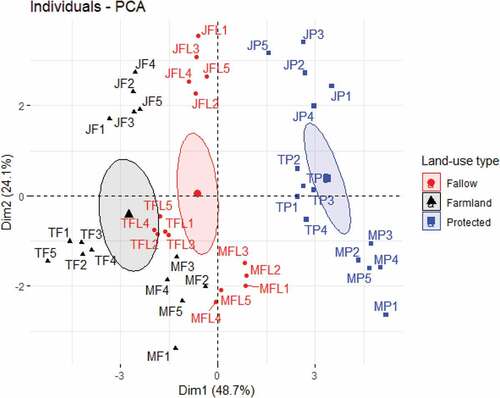
3.4. Plant parts used for herbal remedies
The results of the interviews revealed that the most commonly harvested part used for herbal medicines were roots (34.4%), followed by bark (33.3%), while the flowers (0.5%) were the least used (). For instance, the roots and stripped bark of Balanites aegyptiaca and Pteleopsis suberosa, respectively, were most used while the leaves of Piliostigma thonningii and fruits of Parkia biglobosa were the most utilised parts ().
4. Discussion
Land-use change in sub-Saharan countries is still on the increase (Abdullahi, Citation2021), and this has implication on loss of important biodiversity including medicinal plants which form an important component of health-care provision to rural people in Ghana. Generally, land quality and soil fertility affect plant species productivity and richness (Ahmed et al., Citation2016; Bakhshandeh et al., Citation2019).
Our result showed that different land-use types influenced the abundance and richness of medicinal plants (). The PAs had higher abundance and diverse medicinal plants than both the fallow lands (FL) and FA. Such observation can be attributed to the fact that in the PAs, the medicinal plants are naturally grown and protected without human exploitation while in the FA, farmers are selective in the choice of species retained in their field based on how useful the trees are to their crops and other needs. For instance, farmers may not even know the medicinal importance of the tree species they remove and this could contribute to the decrease in tree species richness and abundance. In a comparative study by Boakye et al. (Citation2017), E.K et al. (Citation2018), and Asinwa et al. (Citation2018), lands which had less disturbance in the Guinea Savanna of Northern Ghana generally had higher number of multipurpose trees with diverse species than lands with more anthropogenic activity.
Interestingly, a previous meta-analysis by Darkoh (Citation2003) found that agriculture in the African drylands had lower species richness and abundance than natural environments, contrary to the findings of García-Vega and Newbold (Citation2020).
In addition, we found that the study areas, especially FA, had many medicinal trees (e.g. Faidherbia albida, Parkia biglobosa, Cassia sieberiana, Tamarindus indica, Afzelia africana, etc) being either leguminous (putative N2-fixing) or produce high amount of green biomass (). The possible extra benefits of these trees to improve the soil fertility could contribute to farmers retaining them on their farms, since Atakora et al. (Citation2019) and Ochire-Boadu et al. (Citation2020) reported that poor soil fertility is a major factor inhibiting crops yield in the Guinea Savanna zone of Northern Ghana.
In addition, leguminous/Fabaceae family have speedy regeneration potential and are known to be resilient species and thrive in extreme weather/dryland conditions (Ilstedt et al., Citation2016; Ouedraogo et al., Citation2017; Oyebamiji et al., Citation2017). This align with our result since our study area () is considered as a dry region of Ghana, with unimodal rainfall pattern characterised by long period of drought (Atakora et al., Citation2019; Ochire-Boadu et al., Citation2020). Therefore, it is not surprising that the leguminous/Fabaceae family species were the most abundant and diverse ().
The results of the PCA ( and ) showed that the abundance and richness of medicinal plants were influenced by variation in the physicochemical properties of the soil in the three land-use types. The PC1 represented the abundance and richness of medicinal plants and the chemical properties of the soil across the different land-use types. The soil chemical properties, namely, pH, organic matter, TN, Pav, exchangeable calcium, CEC and percentage base saturation showed positive loadings on the PC1, which implied that they increased across the different land-use types from FA to FL and then to PA.
Thus, the highest soil nutrients recorded in the PA corresponded with the high abundance and diverse medicinal plants whilst the low soil nutrients in the FA also had a relatively lower abundance and diverse medicinal plants. This clearly showed the impact of management practices on the abundance and richness of the medicinal plants, as tillage practices and chemical weed control in FA is expected to reduce soil organic matter, which is crucial for soil quality and species richness (Ferrero et al., Citation2017; Triantafyllidis et al., Citation2020). Our result further confirms the findings of Siebert et al. (Citation2021) and Gaglio et al. (Citation2017) who reported that PAs function to counter species loss as they are designed to maintain habitat integrity and species richness. In addition, an earlier report by Rodrigues et al. (Citation2018); De Deyn & Kooistra, (Citation2021) and Bartelheimer et al. (Citation2016) indicated that soil properties and plant species diversity/richness differ between forested, fallowed (abandoned) and cultivated lands, indicating that different management practices and soil nutrients are an important edaphic factor that play a role in plant species establishment. A typical case study is in the Mediterranean basin where Balzan et al. (Citation2020) and Plieninger et al. (Citation2014) reported that different land-use types, especially agricultural intensification in arable systems, were associated with reduced plant species and functional diversity/ richness. Our findings prove that changes in land-use practices are the major cause of medicinal plants losses and this should be of grave concern to Africa, especially, since African savannas provide essential ecosystem goods and services to indigenous livelihoods (Inkoom et al., Citation2017; Siebert et al., Citation2021). However, our results contradict the findings of Peña‐Claros et al. (Citation2012) and Nadeau and Sullivan (Citation2015) who indicated that higher tree richness tends to occur on poor soils with low fertility and tree species diversity/richness was not related to any soil variables (K, Ca, Mg, P, Fe, Cu, Zn, Mn, CEC, total N, organic C) as fertility index.
The PC2 that represented the soil physical properties had the clay and silt percentages loading positively while sand loaded negatively on it. This indicated that silt and clay percentages increased across the land-use types from FA to PA while sand content decreased across the land-use types from FA to PA. This might be because during land preparation and tillage, the soil particles are broken down making them loosely held. Further, in a continuous farming with low/poor inputs and little or no intermittent fallow periods, the organic matter content is depleted making the particles further loose.
These are characteristics of our study area (Atakora et al., Citation2019; Ochire-Boadu et al., Citation2020) where farmers rarely practice fallow, and slash and burn method with the use of heavy equipment is widely used during land preparation.
5. Conclusion
Medicinal plants are an important biodiversity in Africa and provide essential ecosystem goods and services to indigenous livelihoods. Unfortunately, change in land use affects the conservation of these medicinal plants. We studied abundance, richness and use of medicinal plants under different land uses in the Guinea Savanna Zone of Northern Ghana and how those plants are influenced by soil characteristics. We established that different land-use types influenced the abundance and richness of medicinal plants. The PA had higher abundance and diverse medicinal plants, followed by the FL while the FA had the least. However, FA had many medicinal trees being either leguminous (putative N2-fixing) or producing high amount of green biomass. In addition, the abundance and richness of medicinal plants were influenced by variation in the physiochemical properties of the soil in the three land-use types. The pH, organic matter, TN, Pav, exchangeable calcium, CEC and percentage base saturation increased from FA to FL and then to PA. However, silt and clay percentages increased from FA to PA while sand content showed a reverse pattern. We further established that significant number of people in the study areas use different parts of the medicinal plants for the treatment of various ailments and it also serves as source of income, health and livelihood.
Our findings suggest that the PA provided a favourable environment for rehabilitation and natural regeneration of soil fertility, growth and richness of medicinal plants. Therefore, it would be necessary to put in place the measures to lessen the effect of the ever-increasing human pressure on the reserves of the savanna ecosystem to avoid a further decline in medicinal plants, loss of biodiversity and soil fertility. In addition, farmers in the FA could consider integrating the medical plants into their crops in an Agroforestry system as alternative to improve the growth and abundance of medicinal plants. Finally, our findings have implications for the attainment of the United Nations Sustainable Development Goals (SDGs), particularly SDG 3 (good health and well-being), SDG 13 (climate action) and SDG 15 (Life on land).
Highlights
Integrating medical plants into crops as Agroforestry system can improve their abundance and richness in cropland use systems.
Conversion of forest land to Agriculture land-use type has negative implications for the attainment of the SDGs 3 (good health and well-being), 13 (climate action) and 15 (Life on land).
Land-use change in sub-Saharan countries is still on the increase and this has implication on loss of important biodiversity including medicinal plants which form an important component of health care provision to rural people.
Data Availability
Data related to the manuscript can be found using the link 10.6084/m9.figshare.20334402
Supplemental Material
Download MS Word (543.6 KB)Supplemental Material
Download MS Word (54.1 KB)Disclosure statement
No potential conflict of interest was reported by the author(s).
Supplementary material
Supplemental data for this article can be accessed online at https://doi.org/10.1080/27669645.2022.2105485
References
- E.K, A., Mensah, R., E.m, A., Yiran, G., J, B.-D., Ametepe, R., & BoadiD, A. (Eds.). (2018). Assessing land and ecosystem management at the local level in the savannah ecological zone and the implications for sustainability. In Strategies for building resilience against climate and ecosystem changes in sub-Saharan Africa (pp. 149–177). Springer.
- Abdullahi, I. N. (2021). Parkland trees under severe drought: An assessment of species diversity and abundance across three agroecological zones of Northern Nigeria. Open Journal of Forestry, 11(2), 117–134. https://doi.org/10.4236/ojf.2021.112009
- Agbodeka, K., Gbekley, H. E., Karou, S. D., Anani, K., Agbonon, A., Tchacondo, T., Batawila, K., Simpore, J., & Gbeassor, M. (2016). Ethnobotanical study of medicinal plants used for the treatment of malaria in the plateau region, Togo. Pharmacognosy Research, 8(5), 12. https://doi.org/10.4103/0974-8490.178646
- Agyei-Baffour, P., Kudolo, A., Quansah, D. Y., & Boateng, D. (2017). Integrating herbal medicine into mainstream healthcare in Ghana: Clients’ acceptability, perceptions and disclosure of use. BMC Complementary and Alternative Medicine, 17(1), 513. https://doi.org/10.1186/s12906-017-2025-4
- Ahmed, Y., Oruonye, E., & Tukura, E. (2016). Dynamics of rosewood (pterocarpus erinaceus) exploitation in savanna lands of Taraba State Nigeria. Sky Journal of Soil Science and Environmental Management, 5(2), 44–51 http://www.skyjournals.org/sjssem/Pdf/2016/Mar/Ahmed%20et%20al%20pdf.pdf.
- Amponsah, I. K., Mensah, A. Y., Ampofo, E. K., Bekoe, S. O., Sarpong, F. M., & Jibira, Y. (2016). Pharmacognostic studies of the leaves and seeds of Cassia occidentalis (Linn.)(Leguminosae). Journal of Pharmacognosy and Phytochemistry, 5(3), 250 https://www.phytojournal.com/archives/2016/vol5issue3/PartD/5-3-15-495.pdf.
- Amujoyegbe, O., Idu, M., Agbedahunsi, J., & Erhabor, J. (2016). Ethnomedicinal survey of medicinal plants used in the management of sickle cell disorder in Southern Nigeria. Journal of Ethnopharmacology, 185, 347–360. https://doi.org/10.1016/j.jep.2016.03.042
- Appiah, B., Amponsah, I. K., Poudyal, A., & Mensah, M. L. K. (2018). Identifying strengths and weaknesses of the integration of biomedical and herbal medicine units in Ghana using the WHO health systems framework: A qualitative study. BMC Complementary and Alternative Medicine, 18(1), 286. https://doi.org/10.1186/s12906-018-2334-2
- Asinwa, I., Olajuyigbe, S., & Adegeye, A. (2018). Tree species diversity, composition and structure in Ogun river watershed, southwestern Nigeria. Journal of Forestry Research and Management, 15(1), 114–134.
- Atakora, W. K., Kwakye, P. K., Weymann, D., & Brüggemann, N. (2019). Stimulus of nitrogen fertilizers and soil characteristics on maize yield and nitrous oxide emission from ferric luvisol in the Guinea Savanna agro-ecological zone of Ghana. Scientific African, 6e00141.
- Atumane, A., & Cabral, P. (2021). Integration of ecosystem services into land use planning in Mozambique. Ecosystems and People, 17(1), 165–177. https://doi.org/10.1080/26395916.2021.1903081
- Bakhshandeh, E., Hossieni, M., Zeraatpisheh, M., & Francaviglia, R. (2019). Land use change effects on soil quality and biological fertility: A case study in northern Iran. European Journal of Soil Biology, 95, 103119. https://doi.org/10.1016/j.ejsobi.2019.103119
- Balzan, M. V., Sadula, R., & Scalvenzi, L. (2020). Assessing ecosystem services supplied by agroecosystems in Mediterranean Europe: A literature review. Land, 9(8), 245. https://doi.org/10.3390/land9080245
- Bartelheimer, M., Poschlod, P., & Stevens, C. (2016). Functional characterizations of Ellenberg indicator values – A review on ecophysiological determinants. Functional Ecology, 30(4), 506–516. https://doi.org/10.1111/13652435.12531
- Boadu, A. A., & Asase, A. (2017). Documentation of herbal medicines used for the treatment and management of human diseases by some communities in southern Ghana. In Evidence-based complementary alternative medicine (pp. 3043061).
- Boakye, E. A., Hyppolite, D. N., Barnes, V. R., & Porembski, S. (2017). Importance of forest buffers for preserving soil carbon and nutrient stocks in farmed landscapes along two river sites in the savannas of the Volta basin, Ghana. Arid Land Research and Management, 31(2), 219–233. https://doi.org/10.1080/15324982.2016.1276984
- Boateng, M. A., Danso-Appiah, A., Turkson, B. K., & B.p, T. (2016). Integrating biomedical and herbal medicine in Ghana – Experiences from the Kumasi South Hospital: A qualitative study. BMC Complementary and Alternative Medicine, 16(1), 189. https://doi.org/10.1186/s12906-016-1163-4
- Buhk, C., Alt, M., Steinbauer, M. J., Beierkuhnlein, C., Warren, S. D., & Jentsch, A. (2017). Homogenizing and diversifying effects of intensive agricultural land-use on plant species beta diversity in Central Europe—A call to adapt our conservation measures. Sci. Total Environ, 576, 225–233. https://doi.org/10.1016/j.scitotenv.2016.10.106
- Cebrián-Piqueras, M. A., Trinogga, J., Grande, C., Minden, V., Maier, M., & Kleyer, M. (2017). Interactions between ecosystem properties and land use clarify spatial strategies to optimize trade-offs between agriculture and species conservation. International Journal of Biodiversity Science, Ecosystem Services & Management, 13(2), 53–66. https://doi.org/10.1080/21513732.2017.1289245
- Coulibaly, M., Sanogo, K., Toure, H. A., Owusu-Prempeh, N., Villamore, G. B., Bredu, S. A., & Manu, E. A. (2021). Abundance and diversity of trees species under different land uses in the sudan Savannah Ecological zone of Ghana, West Africa. American Academic Scientific Research Journal for Engineering, Technology, and Sciences, 76(1), 138–154.
- Darkoh, M. B. K. (2003). Desertification in the drylands: A review of the African situation. Annals of Arid Zone, 42, 289–308.
- De Deyn, G. B., & Kooistra, L. (2021). The role of soils in habitat creation, maintenance and restoration. Philosophical Transactions of the Royal Society B: Biological Sciences, 376(1834), 20200170. https://doi.org/10.1098/rstb.2020.0170
- Dogor, G. K. F., Nyarko, R. A., Anning, A. K., & Oteng-Yeboah, A. (2018). Medicinal plant use and conservation practices by communities in the Togo plateau forest reserve, Ghana. Journal of Medicinal Plants Research, 12(30), 575–589. https://doi.org/10.5897/JMPR2018.6686
- Egeru, A., Wasonga, O., Gabiri, G., MacOpiyo, L., Mburu, J., Majaliwa, M., & Gilbert, J. (2019). Land cover and soil properties influence on forage quantity in a semiarid region in East Africa. Applied and Environmental Soil Science, 2019(1), 1–15. https://doi.org/10.1155/2019/6874268
- Ferrero, R., Lima, M., Davis, A. S., & Gonzalez-Andujar, J. L. (2017). Weed diversity affects soybean and maize yield in a long term experiment in Michigan, USA. Frontiers in Plant Science, 8, 236. https://doi.org/10.3389/fpls.2017.00236
- Gaglio, M., Aschonitis, V. G., Mancuso, M. M., Puig, J. P. R., Moscoso, F., Castaldelli, G., & Fano, E. A. (2017). Changes in land use and ecosystem services in tropical forest areas: A case study in Andes mountains of Ecuador. International Journal of Biodiversity Science, Ecosystem Services & Management, 13(1), 264–279. https://doi.org/10.1080/21513732.2017.1345980
- García-Vega, D., & Newbold, T. (2020). Assessing the effects of land use on biodiversity in the world’s drylands and Mediterranean environments. Biodiversity and Conservation, 29(2), 393–408. https://doi.org/10.1007/s10531-019-01888-4
- Ilstedt, U., Bargués Tobella, A., Bazié, H. R., Bayala, J., Verbeeten, E., Nyberg, G., Sanou, J., Benegas, L., Murdiyarso, D., Laudon, H., Sheil, D., & Malmer, A. (2016). Intermediate tree cover can maximize groundwater recharge in the seasonally dry tropics. Scientific Reports, 6(21930). Article No. https://doi.org/10.1038/srep21930
- Inkoom, J. N., Frank, S., & Fürst, C. (2017). Challenges and opportunities of ecosystem service integration into land use planning in West Africa – An implementation framework. International Journal of Biodiversity Science, Ecosystem Services and Management, 13(2), 67–81. https://doi.org/10.1080/21513732.2017.1296494
- Knudsen, M. T., Hermansen, J. E., Cederberg, C., Herzog, F., Vale, J., Jeanneret, P., Kainz, M., Friedel, J. K., Balázs, K., Fjellstad, W., Kainz, M., Wolfrum, S., & Dennis, P. (2017). Characterization factors for land use impacts on biodiversity in life cycle assessment based on direct measures of plant species richness in European farmland in the ‘temperate broadleaf and mixed forest’biome. Sci. Total Environ, 580, 358–366. https://doi.org/10.1016/j.scitotenv.2016.11.172
- Mensah, M. L., Komlaga, G., Forkuo, A. D., Firempong, C., Anning, A. K., & Dickson, R. A. (2019). Toxicity and safety implications of herbal medicines used in Africa. Herbal Medicine, 63 64–86 doi:10.5772/intechopen.72437 .
- Nadeau, M. B., & Sullivan, T. P. (2015). Relationships between plant biodiversity and soil fertility in a mature tropical forest, Costa Rica. International Journal of Forestry Research, 2015, 1–13. https://doi.org/10.1155/2015/732946
- Negash, M., Yirdaw, E., & Luukkanen, O. (2012). Potential of indigenous multistrata agroforests for maintaining native floristic diversity in the south-eastern Rift Valley escarpment, Ethiopia. Agroforestry Systems, 85(1), 9–28. https://doi.org/10.1007/s10457-011-9408-1
- Nketia, K., Adjadeh, T., & Adiku, S. (2018). Evaluation of suitability of some soils in the forest-Savanna transition and the Guinea Savanna zones of Ghana for maize production. West African Journal of Applied Ecology, 26(1), 61–73 https://www.ajol.info/index.php/wajae/article/view/177602.
- Nwaogu, C., Olawoyin, M. A., Kavianu, V. A., & Pavlů, V. (2016). Soil dynamics, conservation and food supply in the grassland ecological zone of sub-Sahara Africa: The need for sustainable agroecosystem management for maize (Zea mays). Development, Environment and Foresight, 2(2), 61–79 https://www.semanticscholar.org/paper/Soil-dynamics%2C-conservation-and-food-supply-in-the-Nwaogu-Olawoyin/1c05f5c22cf5aa8c22eb1b3b63413100f8ebd47a.
- Ochire-Boadu, K., Abunyewa, A. A., Kaba, J. S., Twum-Ampofo, K., Dawoe, E. L., Agbenyega, O., Barnes, R. V., & Tejada Moral, M. (2020). Improved legume fallows: Influence on nitrogen and microbial dynamics, and maize (Zea mays L) grain yield in sub-humid zone of West Africa. Cogent Food & Agriculture, 6(1), 1785778. https://doi.org/10.1080/23311932.2020.1785778
- Ouedraogo, P., Traoré, S., Barry, S., Dayamba, S. D., & Bayala, J. (2017). Uses and vulnerability of ligneous species exploited by local population of Northern Burkina Faso in their adaptation strategies to changing environments. Agriculture and Food Security, 6, 1–16. https://doi.org/10.1186/s40066-017-0090-z
- Oyebamiji, N. A., Oladoye, A. O., & Ogundijo, D. S. (2017). Influence of leafy biomass Transfer of agroforestry trees with nitrogen fertilizer on maize stover yield in Makera, Nigeria. Journal of Research in Forestry, Wildlife and Environment, 9 (4) , 68–75 https://www.ajol.info/index.php/jrfwe/article/view/165471.
- Pandit, R., Parrotta, J. A., Chaudhary, A. K., D.L, K., Vieira D.L, M., Anker, Y., Chen, R., Morris, J., Harris, J., & Ntshotsho, P. (2020). A framework to evaluate land degradation and restoration responses for improved planning and decision-making. Ecosystems and People, 16(1), 1–18. https://doi.org/10.1080/26395916.2019.1697756
- Peña‐Claros, M., Poorter, L., Alarcón, A., Blate, G., Choque, U., Fredericksen, T. S., Toledo, M., Leaño, C., Licona, J. C., Pariona, W., Putz, F. E., Quevedo, L., & Toledo, M. (2012). Soil effects on forest structure and diversity in a moist and a dry tropical forest. Biotropica, 44(3), 276–283. https://doi.org/10.1111/j.1744-7429.2011.00813.x
- Pérez‐Salicrup, D. R., Sork, V. L., & Putz, F. E. (2001). Lianas and trees in a liana forest of amazonian Bolivia 1. Biotropica, 33(1), 34–47. https://doi.org/10.1111/j.1744-7429.2001.tb00155.x
- Plieninger, T., Hui, C., Gaertner, M., & Huntsinger, L. (2014). The impact of land abandonment on species richness and abundance in the Mediterranean basin: A meta-analysis. Public Library of Science, 9(5), e98355. https://doi.org/10.1371/journal.pone.0098355
- Rodrigues, P. M. S., Schaefer, C. E. G. R., de Oliveira Silva, J., Ferreira Júnior, W. G., Dos Santos, R. M., & Neri, A. V. (2018). The influence of soil on vegetation structure and plant diversity in different tropical savannic and forest habitats. Journal of Plant Ecology, 11(2), 226–236.
- Siebert, F., Van Staden, N., Komape, D. M., Swemmer, A. M., & Siebert, S. J. (2021). Effects of land-use change on herbaceous vegetation in a semi-arid Mopaneveld savanna. Bothalia-African Biodiversity & Conservation, 51(1), 1–26. https://doi.org/10.38201/btha.abc.v51.i1.8
- Smith, S. W., Speed, J. D., Bukombe, J., Hassan, S. N., Lyamuya, R. D., Mtweve, P. J., Sundsdal, A., & Graae, B. J. (2019). Litter type and termites regulate root decomposition across contrasting savanna land‐uses. Oikos, 128(4), 596–607. https://doi.org/10.1111/oik.05697
- Tekalign, M., Van Meerbeek, K., Aerts, R., Norgrove, L., Poesen, J., Nyssen, J., & Muys, B. (2017). Effects of biodiversity loss and restoration scenarios on tree-related ecosystem services. International Journal of Biodiversity Science, Ecosystem Services and Management, 13(1), 434–443. https://doi.org/10.1080/21513732.2017.1399929
- Triantafyllidis, V., Zotos, A., Kosma, C., & Kokkotos, E. (2020). Effect of land-use types on edaphic properties and plant species diversity in Mediterranean agroecosystem. Saudi Journal of Biological Sciences, 27(12), 3676–3690. https://doi.org/10.1016/j.sjbs.2020.08.012
- United Nations Environment Management Group. (2011). Global drylands: A UN-wide response. UN Environment Management Group.
- Youmsi, R. D. F., Fokou, P. V. T., Menkem, E. Z. O., Bakarnga-Via, I., Keumoe, R., Nana, V., & Boyom, F. F. (2017). Ethnobotanical survey of medicinal plants used as insects repellents in six malaria endemic localities of Cameroon. Journal of Ethnobiology and Ethnomedicine, 13(1), 33. https://doi.org/10.1186/s13002-017-0155-x

